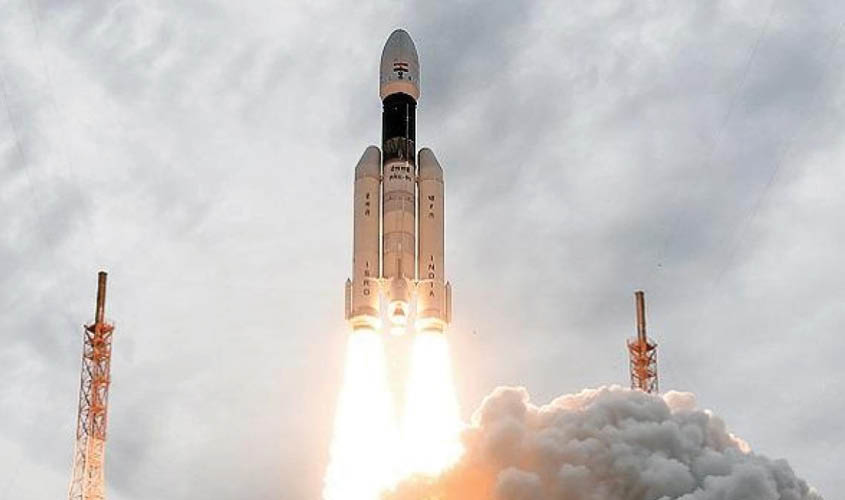The enigma of the moon would have multiplied manifold in the early hours of 7 September 2019, if Chandrayan-2 had made a soft landing on the surface of the Moon. Millions of Indians all over the world were waiting to see the last phase of landing, which didn’t take place. It was certainly unfortunate but at the same time reaching that stage of soft landing itself is praiseworthy. The lander, Vikram failed to land at the designated place and time. But the orbiter has been successfully placed in the lunar orbit, which to a greater extent has been performing the major missions of Chandrayaan-2. Most of the experiments will be conducted at the lunar orbit where the orbiter has been placed. Hence, Chandrayaan-2 may be considered as partially successful.
Initially, on 15 July, the launch of Chandrayaan-2 was called off about an hour before the take-off as a last minute technical snag was detected. And then Chandrayaan-2 was launched on 22 July 2019 at 02.43 pm from Satish Dhawan Space Centre on Sriharikota island in Andhra Pradesh, by means of an ISRO Geosynchronous Satellite Launch Vehicle (GSLV) Mark III. The Chandrayaan-2 stack was initially put in an Earth parking orbit of 170 km perigee and 40,400 km apogee by the launch vehicle. The lander-orbiter pair went into an initial elliptical (170×40,400 km altitude) earth parking orbit, followed by a trans-lunar injection on 14 August. The pair entered the lunar polar orbit on 20 August. The lander and orbiter separated on 2 September. The orbiter evolved into a 100 km altitude circular polar orbit and the Vikram lander manoeuvred into a 30×100 km orbit and then was supposed to land on the lunar surface in the high latitude areas near the South Pole, between the two craters, Manzinus C and Simpelius N, on 7 September at about 1.30 am. This did not take place.
It is unfortunate that India’s attempt to land a robotic spacecraft near the moon’s South Pole did not fulfil the stated objective. The initial phases of the descent had met with remarkable success. But less than two miles above the surface, the trajectory diverged from the planned path. The communications from the lander were lost near the surface, all of a sudden. This might be the result of a computer network error. Whether or not the command sent to shut the engine was correctly done, will be a major part of the debate. Until the communications got lost from the lander, it was travelling at more than 2,000 miles (3,219 km) per hour, at an altitude of about 20 miles (32 km). Despite four of the lander’s engines getting fired in a bid to slow down quickly the speed of the spacecraft, Vikram was descending at a fast pace. This may be the reason why Chandrayaan-2 was not successful completely.
But the orbiter portion of the mission is functioning fine and will last one year.
The Chandrayaan-2 orbiter is a box-shaped craft with an orbital mass of 2,379 kg and solar arrays capable of generating 1000 W power. The orbiter communicates with the Indian Deep Space Network (IDSN) and was supposed to communicate with the lander. The lander was carrying a camera, seismometer, thermal profiler, Langmuir probe, and a NASA-supplied laser retro-reflector. Meanwhile, the orbiter, which has a scientific payload comprising a visible terrain mapping camera, a neutral mass spectrometer, a synthetic aperture radar, a near infrared spectrometer, a radio occultation experiment, a soft X-ray spectrometer and solar X-ray monitor, is working well and doing its designated duties.
It was Chandrayaan-1’s detection of water on the Moon that prompted this course of action for Chandrayaan-2 and Pragyan, the rover that would have conducted further research at the South Pole on the Moon’s surface.
It will be significant to note that India’s Moon mission is important not only because of its scientific feat, but also because of its low budget, which evoked NASA’s interest in it.
Space mission laboratories all over the world will start looking at India for data collection and joint experiments, especially after ISRO’s low cost-high precision lunar model’s successful launch at a later date.
Prime Minister Narendra Modi has echoed very positive sentiments while commending the ISRO scientists. He stayed back till late night, cheered the crestfallen scientists, assured them that the entire nation was with them and hugged and consoled ISRO Chairman, Dr K. Sivan. India will continue with its research and development in the domain of space to become a major power in outer space.
There is no denying that decades of indigenous development in outer space will keep India’s motivations high for meeting its global aspirations. Data is now needed to analyse the reason for the unsuccessful attempt of Chandrayaan-2 to soft-land on the Moon.
Professor Arvind Kumar teaches Geopolitics and International Relations at Manipal Academy of Higher Education, Manipal. Seshadri Chari is a political commentator and strategic analyst.

